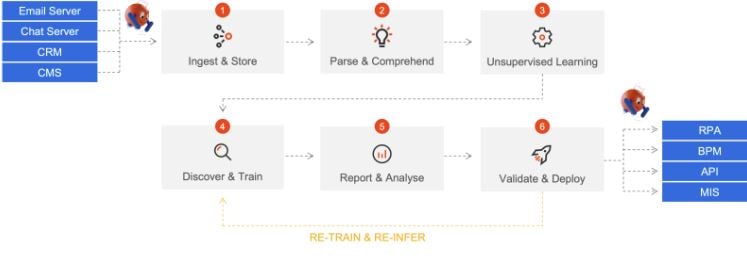End-to-end process automation with UiPath Communications Mining

Introduction
End-to-end process automation is the goal of robotic process automation (RPA). Business processes consist of both structured and unstructured workflows. While RPA has streamlined the former, RPA developers still struggle to make a dent in the countless unstructured processes.
Lack of structured data can frustrate automation efforts. Email is a big culprit, but it's one of many problematic data sources. Ticketing systems, chats, and enterprise system note entries all obstruct RPA developers from delivering successful end-to-end automations. The problem is unstructured data. These manual, communications-based tasks aren’t based on the structured data flows we usually rely on for automation.
As a result, RPA developers usually stick to the easier automations available in their pipelines. But this misses out on the high-value processes revolving around natural language. Automating unstructured processes can provide significant time back to the business and improved CX.
Huge automation opportunities are available in manual communications-based processes, and automation developers lacked the tools by now.
UiPath Communications Mining
Natural language processing (NLP) has finally matured as a technology. NLP is a branch of artificial intelligence (AI) that helps machines understand and process human language-especially natural language found in conversations.
It used to be the case that NLP models could prove unreliable. Their performance was hard to measure, and their value difficult to prove. But recent advances, including transformers, low-code, and large language models, have made it much faster to train, deploy and create value from NLP.
Years of NLP advancements have converged in UiPath Communications Mining. Communications Mining makes it easy for business users and RPA developers to deploy custom machine learning models to automate unstructured business processes. This is done through a powerful, no-code training interface that anyone can use. Communications Mining makes it quick and easy to train models that understand business conversations and turns them into structured data for downstream processing.
Communications Mining has some very useful applications for automation teams as it follows:
Process discovery and definition
Traditionally, processes have been discovered by interviewing process SMEs, which has brought good results in the past. Yet, all too often important information like additional processes is forgotten or isn’t communicated properly.
The value of Communications Mining is spotlighting for RPA developers another avenue to go down for that insight. Clustering and unsupervised learning techniques make finding new issues and opportunities in unstructured data much faster. When deployed across a business’s comms channels, Communications Mining reveals hidden and forgotten issues and manual processes.
Process automation, analytics, and reporting
Manual comms tasks, like email processing, have always lacked the structured data needed for automation. This is probably the most important application of Communications Mining. It reliably converts unstructured comms data into structured data that’s ready for automation. RPA developers now have the structured data they need to build software bots for even the most complex comms processes.
For the first time, RPA developers can automate business processes from end-to-end. They’re no longer limited to structured workflows that involve the tail-end of a process. Where data is missing, RPA developers can now create their own.
Communications Mining also provides built-in analytics and reporting capabilities. This enables developers to analyze automation performance, measure system exceptions, and prove the value their automations are driving for the business.
How does Communications Mining work?
Here’s a breakdown of how to get the most value from UiPath Communications Mining.

Before anything can happen, Communications Mining needs to be connected to a data source. The main requirement is a store of natural language text data, like an shared email mailbox or ticketing system. Communications Mining offers prebuilt connectors for major enterprise systems like Salesforce, Zendesk, and Pega.
Common themes and semantic intents are grouped together to provide visibility across business communications channels. Historically, siloed insight capabilities would have looked at channel-specific communications.
AI and machine learning take the heavy lifting out of manually categorizing these communications. The process is completely unsupervised, requiring no training. AI can process vast amounts of information, providing value in the volume and quality of analytics. What takes human employees months or even years to accomplish, Communications Mining does in hours.
Communications Mining models still require some training to be customized to specific industries and use cases. But training times are still far below the norm. The ‘active learning’ approach combines human expertise with machine efficiency, creating an active feedback loop between the model and the people training it. Using in-built analytics, you can prove your improvements have worked and are driving a positive return on investment. The key here's having data to prove the value you've created, something previously difficult to measure.
Communications Mining automates a large part of model maintenance and validation. Alerting users when a model requires further training or refinement. For example, this could be necessary when there’s a large influx of new data to the platform.
Conclusion
Communications Mining has become a critical tool and enabler of RPA. It has created an entirely new category of structured data that developers can analyze and use for automation. Now, communications-based processes can be automated. Creating new opportunities and extending the scope and value of automation projects.
Start your trail and see how Communications Mining can add more value to your automation projects by visiting our dedicated product page.
Topics:
AISenior Solution Architect, UiPath
Get articles from automation experts in your inbox
SubscribeGet articles from automation experts in your inbox
Sign up today and we'll email you the newest articles every week.
Thank you for subscribing!
Thank you for subscribing! Each week, we'll send the best automation blog posts straight to your inbox.



